|
Gross domestic product — The service sector dominates the Australian economy accounting for about 68 percent of gross domestic product. But its agricultural and mining sectors, which combined account for only 8 percent of GDP account for 65 percent of its exports. Manufacturing accounts for less than 12 percent of GDP. Australia is a major exporter of agricultural products, particularly grains and wool, and minerals including various metals, coal and natural gas. A downturn in world commodity prices can thus have a large impact on the economy. Australia's competitive advantage in primary products is a reflection of the natural wealth of the Australian continent and its small domestic market. Just over 21 million people occupy a continent the size of the contiguous United States.
GDP was up 0.5 percent in the third quarter after increasing 0.6 percent in the second quarter. On the year, GDP was up 3.1 percent. Quarterly growth was driven by a 0.5 percent contribution from private business investment, a 0.3 percent contribution from changes in inventories and a 0.2 percent contribution from household final consumption expenditure. These increases were partially offset by a negative 0.5 percent contribution from public investment. The industries that drove growth in the September quarter were mining, manufacturing and health. Mining contributed 0.4 percent while both manufacturing and health contributed 0.1 percent to the increase in GDP. Final consumption expenditures were up 0.1 percent and 3.3 percent on the year. Gross fixed investment was up 0.4 percent on the quarter and 4.5 percent on the year.
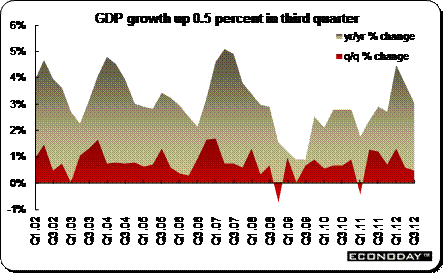
Like Canada, and unlike the U.S., Australia releases GDP data once a quarter, usually about two or more months after the reference quarter’s end and is usually the last of the major industrial countries to do so.
Retail sales — Like all consumer based economies, retail sales data provide a more current look at the sector’s health. Sales were dampened by the RBA’s three interest rate increases in 2009. Earlier in 2011, sales weakened as the interest rate increases began to bite. The RBA had increased rates seven times and retail sales continue to show the impact. The Queensland floods also put a dent into sales.
Sales so far in 2012 have been weak even though they were positive for the first six months. They sagged 0.8 percent on the month in July but increased in August and September. However, October’s retail sales were unchanged on the month. On the year, sales were up 3.1 percent. The only industry to increase was food retailing (0.9 percent). This was offset by declines in household goods retailing (down 1.6 percent), other retailing (down 0.5 percent), cafes, restaurants & takeaway food services (down 0.3 percent), department stores (down 0.1 percent) and clothing, footwear & personal accessory retailing (down 0.1 percent).
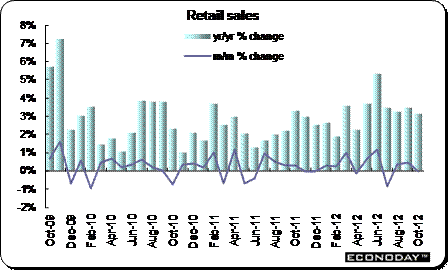
Inflation — Unlike most other industrial nations, Australia releases its consumer price index and producer price indexes only once a quarter rather than every month. Third quarter CPI was up 1.4 percent on the quarter and was up 2.0 percent when compared with the same quarter a year ago. However, the preferred RBA inflation measure — the trimmed mean was up 0.7 percent and 2.4 percent on the year while the weighted median was 0.8 percent higher on the quarter and 2.6 percent above a year ago. On July 1, 2012 the Australian Government introduced a $23 per tonne carbon price on greenhouse emissions, to be paid directly by Australia's largest greenhouse gas emitting companies, together with compensation and incentive packages. Carbon pricing changes the relative prices of high and low emission intensive goods. The ABS will not be able to quantify the impact of carbon pricing, compensation or other government incentives and will not be producing estimates of price change exclusive of the carbon price or measuring the impact of the carbon price.
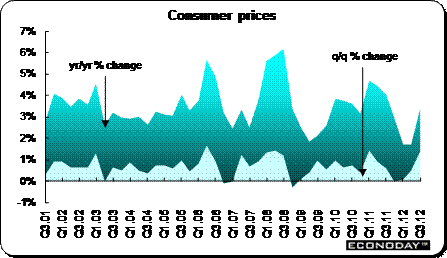
Third quarter producer prices jumped 0.6 percent on the quarter and were up 1.1 percent when compared to the same quarter a year ago.
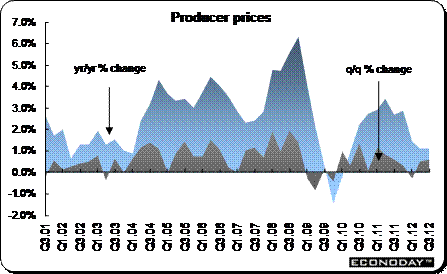
Unemployment — A major problem for the Australian economy was not underemployment but rather a labor shortage that threatened to drive up wages and inflation. After reaching a low of 4.1 percent in August 2008, the unemployment rate climbed to 5.8 percent in June 2009 and remained at or near that level for several months. The unemployment rate declined to 4.9 percent in mid-2011 and is currently 5.4 percent. However, employment growth has slowed markedly. In 2010, employment for the year was up over 363,000 jobs. In 2011, employment slipped by 1,100. For the eleven months of 2012 through November, employment is up 158,300 even though it declined in February, June and August.
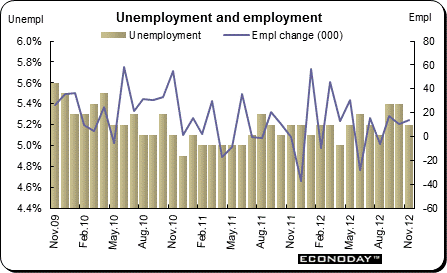
Merchandise trade — Trade was in surplus for 11 of 12 months in 2011. However, trade now has recorded a deficit in every month so far in 2012. Both exports and imports have declined five of nine months in 2012. Exports have been hit by weakening growth especially in China and the strong Australian dollar.
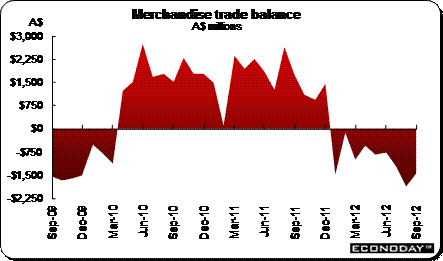
|